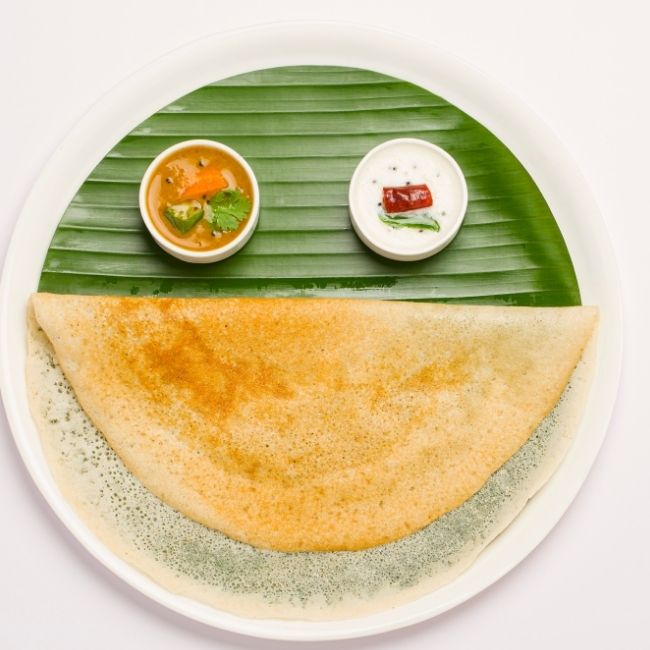
Eat Street Chronicles: The Dosa, A Culinary Love Letter
Recommended for Foundational Grades
Imagine a food so versatile it can be a canvas for a symphony of flavors, a breakfast staple, a late-night craving buster, and a cultural icon all rolled into one. Welcome to the world of the dosa, a South Indian culinary gem that has captured hearts (and taste buds) across the globe.
In this exploration, we’ll journey through the heart of dosa country, uncovering its humble origins, marveling at its simple yet ingenious preparation, and basking in the sheer variety that this dish offers. Get ready to tantalize your senses and perhaps even inspire a trip to your nearest South Indian eatery. As they say, the proof of the pudding – or in this case, the dosa – is in the eating!
The Dosa’s Humble Beginnings – A Batter of History
Like a well-loved story passed down through generations, the dosa’s origins are shrouded in a bit of mystery, with mentions dating back to the ancient Sangam literature of South India. It’s a testament to the dish’s enduring appeal and its ability to evolve with the times.
“The dosa, like a fine wine, has only gotten better with age,” a wise old chef once told me, his eyes twinkling with the memories of countless dosas flipped and served.
The beauty of the dosa lies in its simplicity. Rice and urad dal (black lentils), two humble ingredients, form the backbone of this culinary masterpiece. A pinch of salt and a night of fermentation work their magic, transforming the batter into a symphony of flavors waiting to be unleashed.
The dosa batter is a living thing, its fermentation a delicate dance of microbes and time. A perfectly fermented batter is light, airy, and slightly tangy, the key to a dosa that’s crisp on the outside and soft on the inside. It’s a skill honed over generations, passed down from mother to daughter, a culinary legacy etched in the heart of every South Indian kitchen.
From Batter to Plate – The Dosa’s Transformation
The transformation of the batter into a dosa is a sight to behold. A ladleful of batter is poured onto a hot griddle, its sizzle announcing the beginning of the magic. With a deft swirl of the ladle, the batter spreads into a thin, even layer, its edges turning golden brown, a visual symphony of culinary artistry.
As the dosa cooks, tiny bubbles form on its surface, a sign that it’s ready to be flipped. A gentle nudge with a spatula, and the dosa is turned, revealing its crisp, golden underside. A drizzle of oil, a few more moments on the griddle, and it’s ready to be served, its aroma filling the air with anticipation.
The dosa is more than just a meal, it’s a feast for the senses. The sight of its golden brown exterior, the sound of its crispness as you break it, the aroma of the cooked batter, and the taste of its perfect balance of flavors, all come together to create a culinary experience that’s truly unforgettable.
Dosa’s Delicious Diversity – A Culinary Kaleidoscope
The classic dosa, served with a dollop of coconut chutney and a bowl of sambar, is a South Indian breakfast staple. The cool, creamy chutney complements the crisp dosa, while the tangy, flavorful sambar adds depth and warmth. It’s a combination that’s both comforting and satisfying, a perfect way to start the day.
The dosa’s versatility is its greatest strength. It can be stuffed with a variety of fillings, from the classic masala dosa with its spiced potato filling to the more modern pizza dosa with its cheesy, tomato-laden topping. The possibilities are endless, limited only by your imagination.
The dosa is not just a breakfast food, it’s a meal for any time of day. From the simple plain dosa to the elaborate ragi dosa, there’s a dosa for every occasion and every palate. It’s a dish that’s both nutritious and delicious, a testament to the ingenuity of South Indian cuisine.
“A dosa a day keeps the hunger pangs away,” my mother always said, and I couldn’t agree more.
A Culinary Legacy
The dosa is more than just a food, it’s a culinary legacy, a testament to the rich and diverse culture of South India. It’s a dish that’s both simple and complex, humble and sophisticated, traditional and modern. It’s a dish that’s loved by millions, a culinary ambassador that has crossed borders and cultures, bringing people together through the universal language of food.
So, the next time you see a dosa on a menu, don’t hesitate to order it. Take a bite, savor its flavors, and let it transport you to the sun-drenched streets of South India, where the sizzle of the griddle and the aroma of freshly made dosas fill the air. It’s a culinary adventure you won’t regret.
What is your favourite kind of dosa?
Watch a video
Crispy, flavorful, and oh-so-delicious Mysore Masala Dosa!
Curious Times is a leading newspaper and website for kids. We publish daily global news aligned to your learning levels (also as per NEP 2020): Foundational, Preparatory (Primary), Middle and Senior. So, check out the News tab for this. We bring kids’ favourite Curious Times Weekly newspaper every weekend with top news, feature stories and kids’ contributions.
Curious Times News Program for Schools for FREE. Over 5,000 schools and teachers from all over the world have joined our programme so that students and teachers can get FREE Educative Newspaper. Here, kids can take part in world events and win prizes and certificates for free through their schools.
The following social media platforms allow you to communicate with us: Instagram.
0 (Please login to give a Curious Clap to your friend.)
